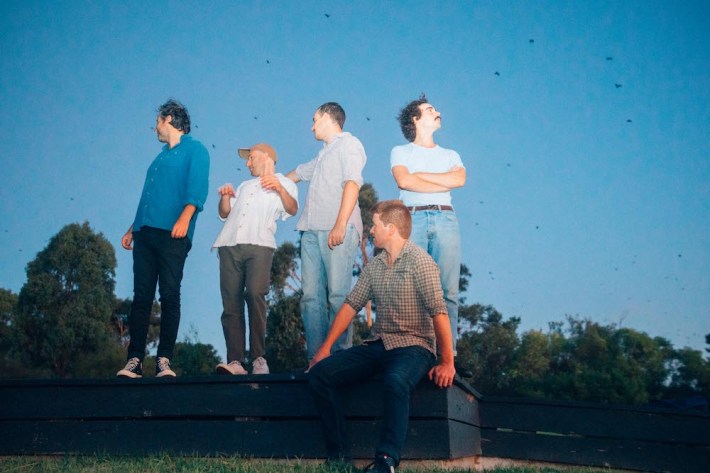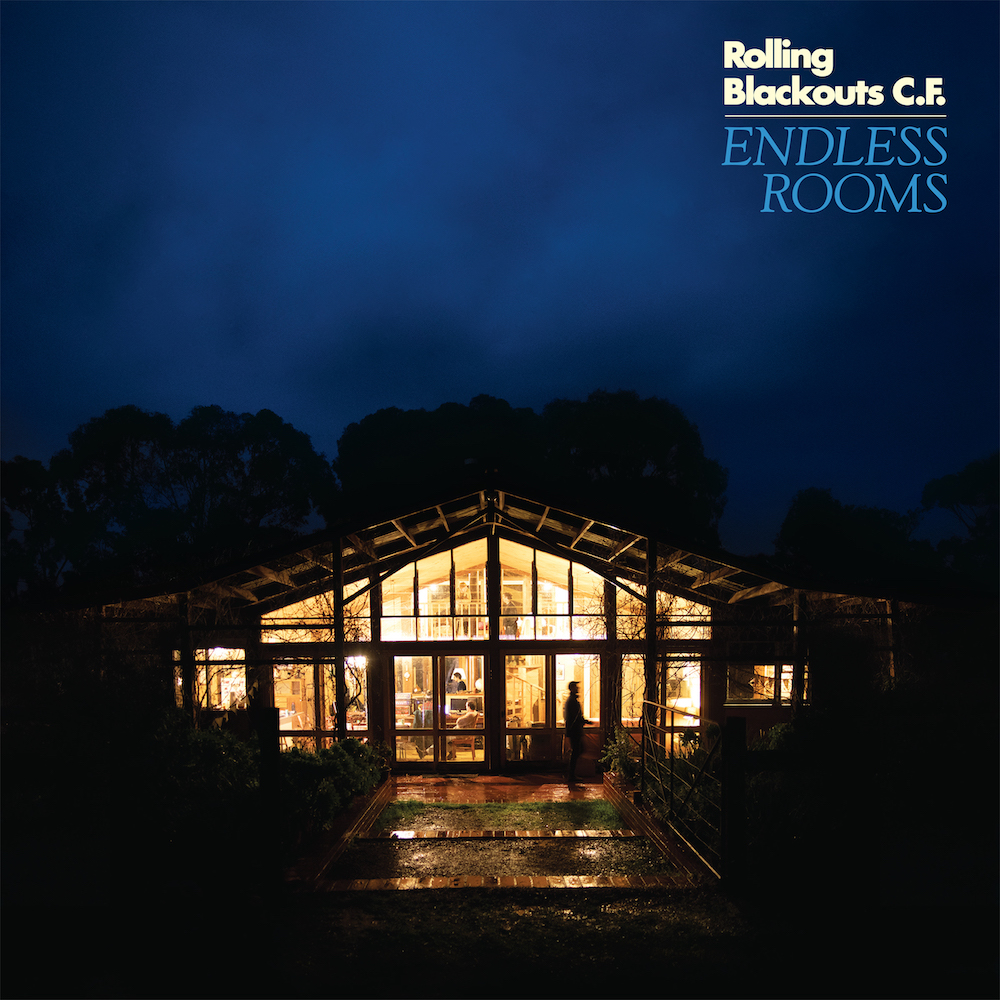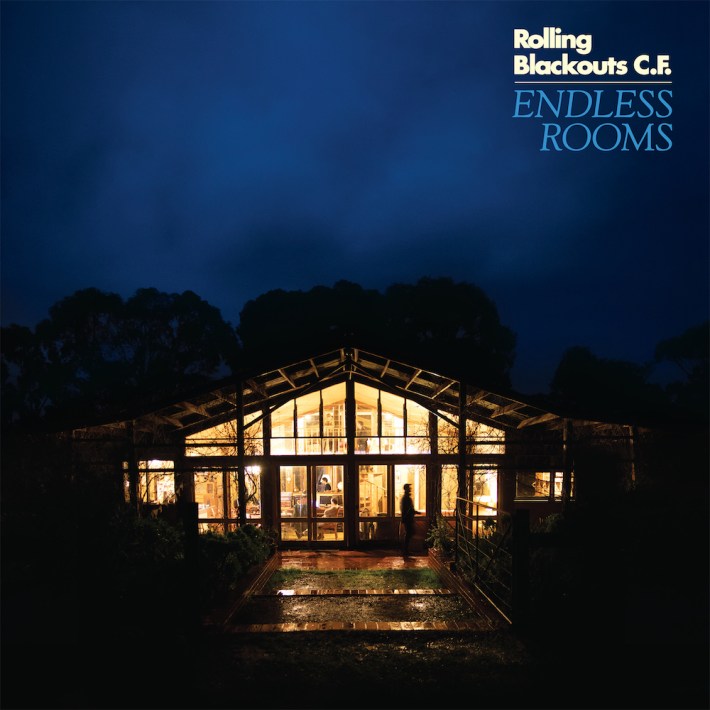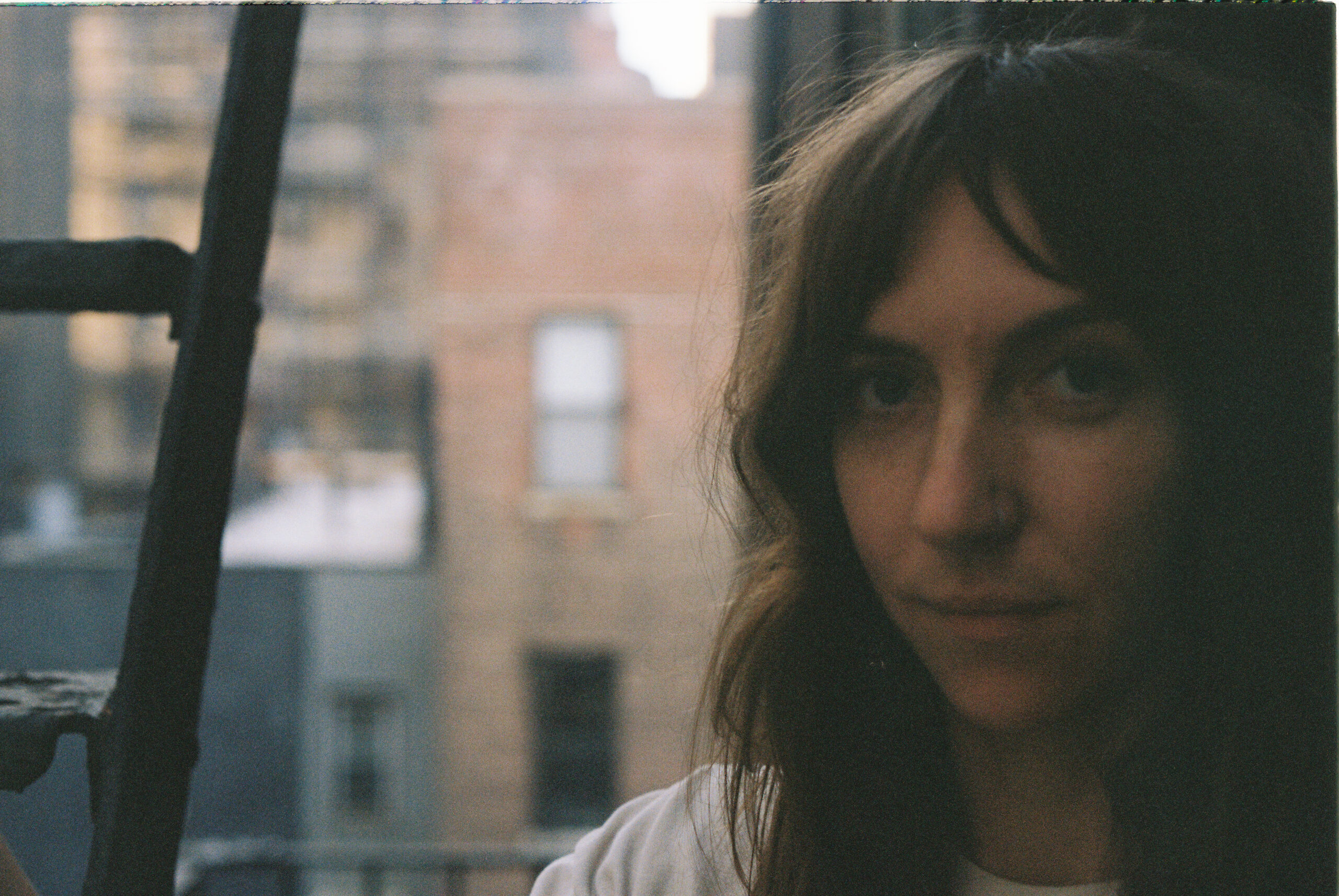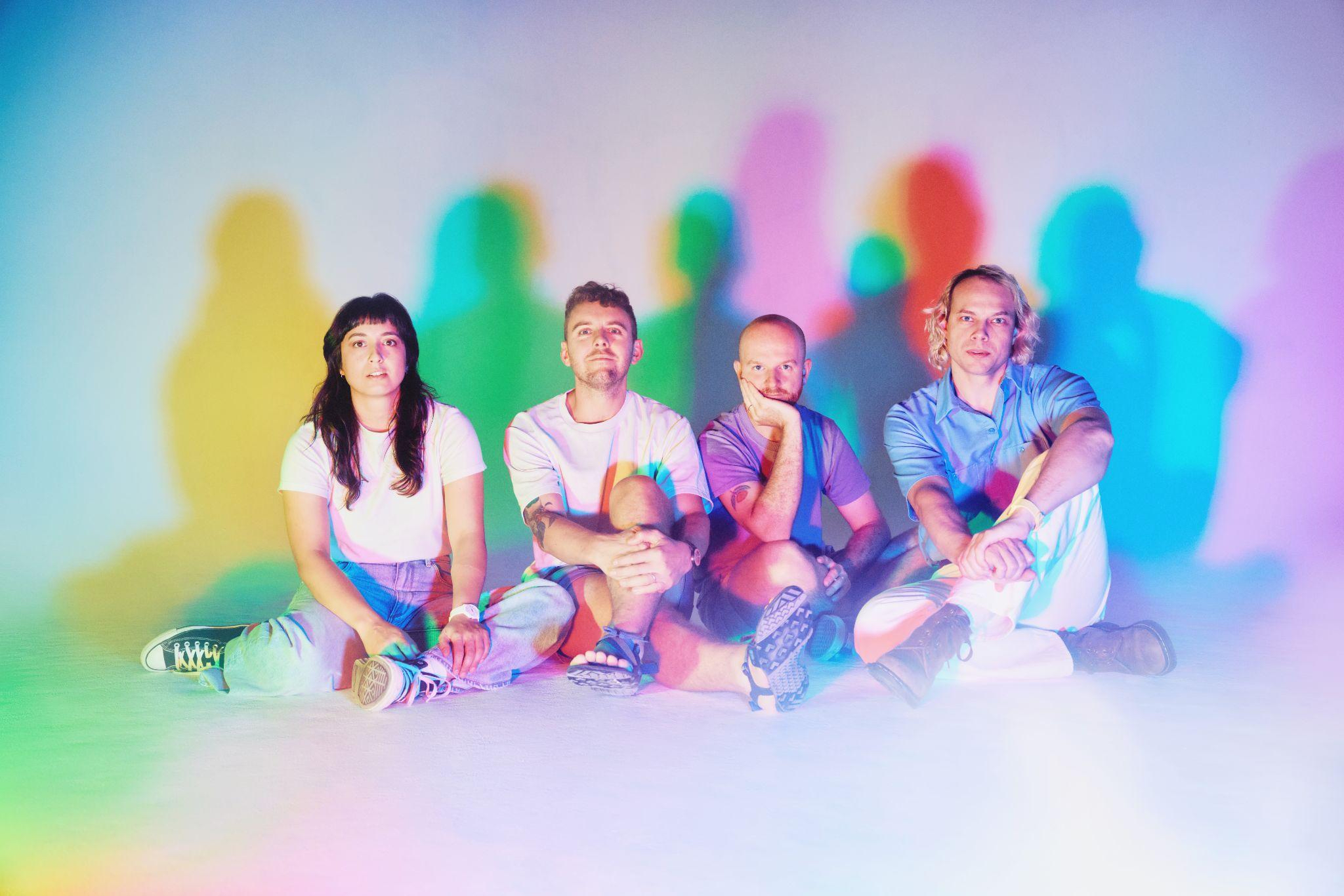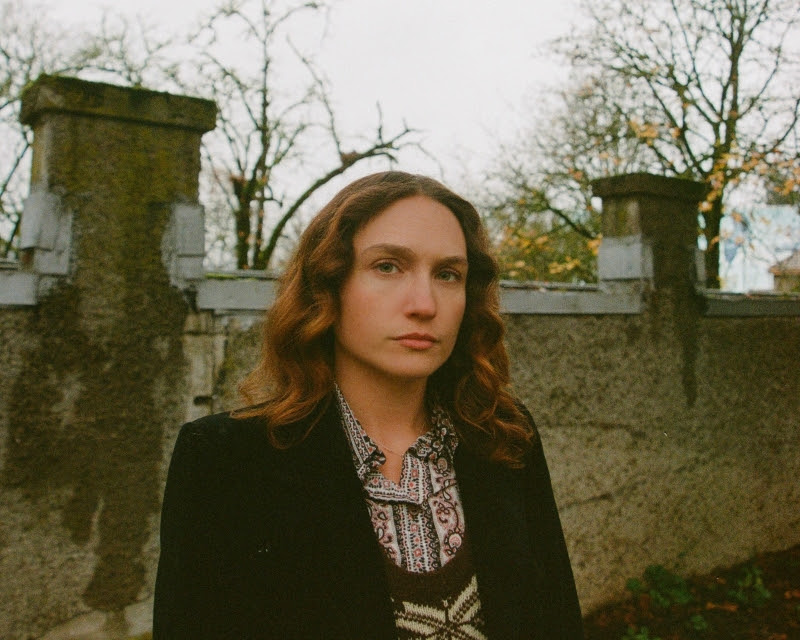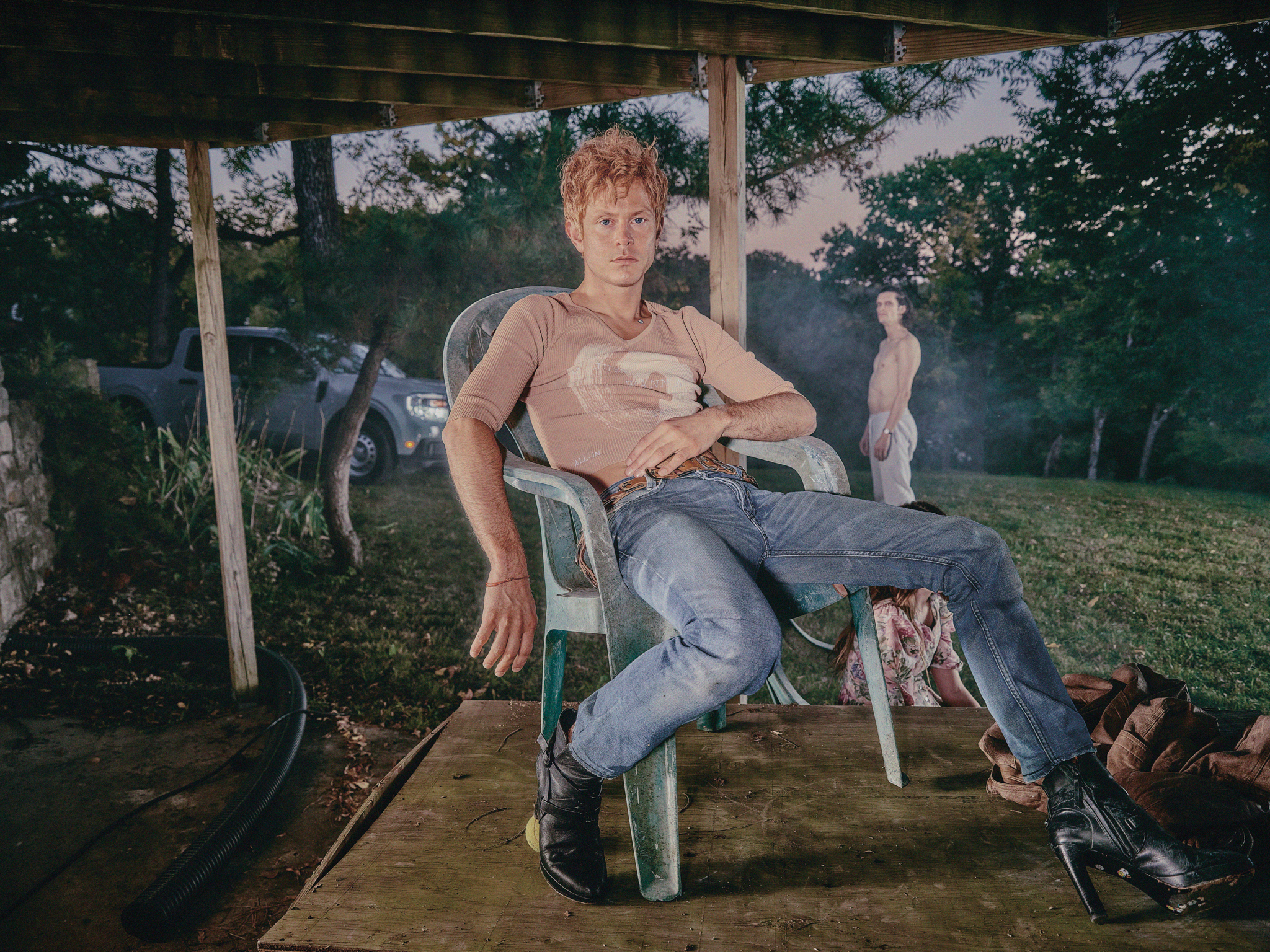Rolling Blackouts Coastal Fever, the reliable purveyors of gleaming and infectious jangle-rock, are back with a new album. Endless Rooms began life as demos traded between the band's five members -- vocalist/guitarists Joe White, Fran Keaney, and Tom Russo, alongside bassist Joe Russo and drummer Marcel Tussie -- during Australia's strict pandemic lockdowns. When they were able to meet in person, the band convened at a countryside house built by the Russo brothers' family in the '70s. There, they began bringing the new tracks to life, but also using the house to find the sound of their latest collection.
The result was something they called an "anti-concept" record. The only overarching themes for Endless Rooms are the place where it was birthed, and one meaning behind the title. RBCF began to consider their identity as songwriters, how they treat each composition as a world they can build out and then hone in on, until every element sits just right. Ahead of the album's release, we got on Zoom with Keaney, White, and Tom Russo to talk about each song on the album -- how the band subtly pushed their sound, how these songs went through different lives, and how we eventually ended up with another batch of material that, after a listen or two, you can't shake. Now that you can hear it for yourself, listen and read our conversation below.
1. "Pearl Like You" / 2. "Tidal River"
JOE WHITE: A lot of the time, a record is a response to the last record. We were heading towards weirder structures and experimenting a bit more with [Sideways To New Italy]. We got into the studio with our producer Burke Reid, and it kind of straightened a lot of things out and made it a bit more pop and pulled us into line a bit. For this one, we were responding to that. We pushed it a little bit. That little opening track was something Joe Russo had made on his loop pedal for months and months and we fell in love with the melody.
TOM RUSSO: He wrote that one because we was living down at the beach with his girlfriend. He would just build up these loop symphonies, keeping the pedal on for hours at a time. He would just live in the world of that loop for a while. On the two albums... I feel like with Sideways, we were really trying to pull it apart and let songs move in any which way they wanted to with intuition. If a chorus only happens once and it’s at the end of the song, and that feels right, then that's how that song should go. We were trying to follow our noses a bit, but we didn’t quite get there. An outsider like Burke would say we needed some screws tightened, and he helped us do that.
With this album, we were a bit more confident we could know when to let things breathe, know when to rein things in. That's always been the push and pull in our band. Yes, they're pop songs, but sometimes they need to bloat, sometimes they need to stretch out. I think we're getting a better command of when to do that.
You’ve talked about the idea that you guys could not see each other a lot because of the stricter lockdowns in Australia, and then it all came together when you could gather in this house. That was different than the other albums, in that songs would've come to the band more fully-formed than in the past.
WHITE: For this record, definitely. I think we were all at home recording and writing little demos. Usually we'd bring an unfinished idea to the band, but this time we had nothing else to do but try to finish a song, get the end of it, put an outro or full stop on it. There were a few songs that came to the process where the structure was done and we just had to put it together or get the vibe right. It’s a pretty different process for us.
When "Tidal River" came out, you talked about this myth of Australia as "the lucky country."
RUSSO: It was coined in the '60s. I'm sure there's some American ones, like an exceptionalism. The idea is that Australia is lucky because it's blessed with natural resources and prosperity. The flipside of that is that it's this myth. A lot of people pat themselves on the back. It's a very stable and established and rich country -- which, of course, as with America, it's not that way for everyone. It might be that way for the majority. The obvious thing is it's not the lucky country for the First People that were dispossessed and continue to suffer from that.
[The song] is a bit of a reaction to that, particularly in the politics that have been going on the last few years. We’re being lead by a very uninspiring conservative reactionary government. There’s been no vision. It’s been this very apathetic time. Which might be potentially changing. Because we are so blessed in these ways to have these advantages, there is so much potential to do better -- as with the States. It feels like that’s a long, winding process. It’s because a lot of the people who are most lucky... They have all these riches and privilege, and instead of trying to make things better, there’s a lot of selfishness and burying of heads in the sand. Sitting at home during lockdown, I was just playing this riff over and over on an unplugged electric guitar sitting there watching things fall apart. It was an angsty reaction to that, that we should be doing better.
In the bio for the album, you said you're not necessarily an angry band, or that people don't see you that way, but there's a bit more darkness in this album. It seems there’s slightly more recurring social analyses. Does it feel more collectively focused on current events for you all?
FRAN KEANEY: I think just overall, the album is a little less fantastical. It's a bit more... not autobiographical, but personal. The other albums were, but this is a clearer snapshot of how we were feeling at the time, in 2020. It’s always the case that the political stuff bleeds into the personal. “The Way It Shatters,” “Tidal River,” “Bounce Off The Bottom,” they’ve all got the social landscape in there.
RUSSO: It puts it in such relief. The pandemic thing -- though we don’t write about that, because no one really wants to hear about that. Stuff like the fires, it was this traumatic national experience. It just gets to that point where if you’re not angry, you’re not paying attention. We're not really an angry band, but you can’t divorce the context of what we’re doing from what’s going on around us.
3. "The Way It Shatters"
This has some similar themes, right, like the idea of some people being born into a prosperous country and some born into a war zone?
WHITE: Yeah. We were just jamming on it and Fran said we should call it "The Way It Shatters." It’s from a Violet Crumble ad, a honeycomb and chocolate bar. Which led me to sort of write about absolute, complete randomness -- the way a window will only shatter that way once, there's nothing uniform about it. I was writing random, weird things, which in the end I couldn’t get behind it because it was all a bit too esoteric.
The idea of the way it shatters, the way things work or land, really is just how we ended up here and how someone else ended up there. Almost hoarding that luckiness, that attitude Australia has. To the point where we not only reap the benefits of our lucky country but we also defend it to the point that we lock people up in offshore prisons for trying to get here. Then how easily we can defend that. Our current prime minister is a very outwardly Christian man that defends his Christian ideals — like he’s hiding behind this idea of his values while at the same time ignoring the fact there’s all these people locked for the random fact of where they were born. That gave the song a stronger meaning.
It’s mostly about Violet Crumbles though. [Laughs]
That lead riff was one of those elements on the album where I thought it was something a bit different, just in terms of timbre. You wrote this song at home on a synthesizer right?
WHITE: That riff was on a synthesizer, yeah. Musically, it was all written on keys. That’s probably new. I do a lot of writing on keys but not for this band, I guess. This is one where it was so synth-y in the demo, I just took it to the band to see what happens, and then it worked.
4. “Caught Low”
RUSSO: First of all, that song has been through a few lives. It started as this big jam, another song we’d dubbed “Grand Funk” because it sounded like a real American rock song. It was too American jam band. Joe Russo turned it into this synth loop -- I think the synth is a lot more prominent in the writing of these songs. We brought it back and I put my lyrics over the top of it. It’s not so much political, this one. It’s inspired by being on tour in the United States.
We played Coachella, which was an interesting experience for us because of the unnaturalness of it. You fly out over Indio and Palm Springs and there’s these beautiful green lawns in the middle of the desert and it’s stunning but then you hear they’re there because the Colorado River is being diverted. Then there’s this huge decadent party [at the festival], and you’re just like... “Should this be here?” We were staying on an off-day in Redding, California. Just this huge new building estate, this brand new house that hadn’t been used, sitting out in this beautiful California evening. The lawns are perfectly cut and there’s frogs jumping in the lawns and there’s a fake fireplace and you’re walking down this perfect concrete on these streets -- and there’s not a soul around. It was this uncanny experience, like you’re in the The Sims.
I was thinking about a bit of a love story in a place like that. Juxtaposing actual human life against the indifferent landscape. How suburbia is kind of the opposite of nature. It’s almost a wasteland, this landscape. There’s always phone towers right by the houses in the US states, you’re just walking by and ignoring that. The “movie’s gotten boring” line, that’s also knowing that all of that is temporary. It’s all being made but it’s all unnatural and you have to pay for that somehow. But yeah it’s a love story set in a new, empty housing estate.
WHITE: I remember that housing estate and we didn’t hear any evidence of a human the entire time except for the hum of air conditioners.
RUSSO: It was so eerie, thousands of air conditioners just humming.
“An air conditioned city” huh.
WHITE: [Laughs] No one walking around, just frogs.
5. “My Echo”
I feel like that sort of dislocation appears in your music often -- or at least, we certainly talked about that with travel and Sideways To New Italy. “My Echo” is a very daily kind of dislocation, through digital life.
KEANEY: Yeah, that’s right. Heightened by 2020 stuff. There’s that Black Mirror episode where that guy lives in that unit where he’s got to keep exercising. He lives a drone-like experience. In fact, we were watching Black Mirror in Redding.
RUSSO: Not a good place to watch something like that. You get a bit of existential dread.
KEANEY: I don’t want to harp on about lockdown, but there was a period where the rest of Australia was going alright, pretty much Covid-free. Melbourne, where we live, in particular had this ring of steel around it where we were locked down for months, where the rest of the states were going OK. Particularly WA and Queensland. So they moved the AFL football competition into state. It’s predominantly a Victorian sport. All the Victorian teams were bubbling out into state and playing these game pretty much for the Melbourne market. We were all like these battery hens sitting at home with a drip feed of football. They made this festival, where they had a game on every night for some period of time -- Australian sport is not like American sport where there’s sport going all the time, ours is predominantly on the weekends.
It was the only thing I did, and I think it was the only thing a lot of people did: work from home and just watch football and be inundated with football analysis and betting odds. That just became life. You punctuate that with checking your phone or working on your computer screen. [The song] is born out of that, the dystopian themes we lived through for a while. Just trudging around like a lemming around the well-worn paths of your home. I didn’t really want to write any pandemic songs, but this one fell out and it’s truth so it’s like, OK, we’ll allow this one.
The actual song was born out of a jam we’d had when we were doing a live session in 2020. It was just an iPhone recording. It was Joe Russo’s bassline with the chords I had, and it felt good straight away. So we turned that into the rest of the song. With this song, I really tried to let the vocal melodies guide the song a lot more. A lot of time when I write, I’m thinking about chords and the melody comes after. This time the melody drives it and the chords follow. The verse and chorus chords aren’t that different from one another. They just back up what the vocals do. In terms of actually fleshing it out, when we were able to get back together again at the end of 2020, we went to do some demos and Tom ad-libbed this Neil Young-y Crazyhorse guitar. We sort of had demo-itis with that demo, and Tom basically ended up emulating most of those initial improvised leads.
6. “Dive Deep”
RUSSO: During lockdown -- I don’t know if you know this cartoonist Bjenny Montero, but he has a good cartoon where someone’s interviewing someone and they’re like, “So, I hear you made the new album during lockdown” and it’s like “Yep, we made the new album during lockdown.” Everyone’s in that boat. It’s kind of boring but you have to keep referring to it. I got a Roland TR-8 drum machine while we were locked down, just to play with. I was making lots of different kind of songs.
“Dive Deep” started as a drum machine experiment, putting a straight beat down and building it piece by piece, this weird little funky jam thing. It’s a bit different than our usual Blackouts songs, because it didn’t come about organically at all. It was very much a bedroom pop thing. I was a bit nervous when I took it to the band, it just wouldn’t translate. It went pretty well. We basically reinterpreted it as a live band song, it got a bit more ‘70s or something. Joe White played that big guitar hook, that huge sound.
WHITE: That was a fun one. Tom’s demo was about eight minutes -- no structure, just a bunch of different melodies and chord changes and vocals. It was almost stream of consciousness, seemingly no order to it. So we basically just extracted all our favorite parts of that and turned it into what’s recognizable as verse, chorus, pre-chorus, lead. It was a fun exercise, having such good bits all there at our disposal and [figuring out] what to do with them.
KEANEY: I feel like that’s the song that gave shape to the whole album. That was one of the few we worked on during our session in December of 2020. We were trialing whether to see recording an album there would work and to see what we’d come up with during our time apart. We put the amp upstairs and had it really hot. We were listening to it back near the fireplace under the stars and it had this celestial kind of feel. That was the glue for the rest of the album, I reckon.
WHITE: We really liked the drum sound we were getting. It was when it clicked that this sound, this house, was integral to the album.
7. “Open Up Your Window”
WHITE: This is an old one. We were jamming on this well before Sideways. It was like an eight minute song, we were intending to make it that way. It was a one minute vocal bit and then there was this real up and down long jam. We were still intending to do that until one of us said, “Fuck that, why don’t we make it a two minute song.” [Laughs] How are we going to fit this on a record? How’s it going to become this piece that matches everything else? Making it two minutes was the answer, boiling it down to its essential parts.
KEANEY: We were talking about putting it out when lockdown first happened but we didn’t. It feels like a lockdown song. I showed it to my sister and she was like, “Did you write this during the pandemic?” and I was like “No! Not at all!” The “Open Up Your Window” thing --Bob Dylan said this thing about Australia. I can’t remember the exact quote but he was like, it’s this beautiful country but the whole of the nation has got its windows shut. It’s closed off from the beautiful country that it is. We all congregate, as Tom says, to the water’s edge -- we all congregate around these major cities. But it’s this vast, beautiful place. Many of us don’t really engage with it. We sort of block out the natural world.
RUSSO: I thought Bob Dylan meant that more of a diss. Back in the ‘70s, like we didn’t have our intellectual windows open. I think he was saying it was a small-minded place. [Laughs] Which is kind of... related.
KEANEY: Yeah, small-minded. But anyway, that song is about opening up. Not literally opening up your window but opening up if you’re closed off. It’s a nice song to play. It feels cathartic.
8. “Blue Eye Lake”
You guys have a tendency to bury my favorites later on the album -- it was "Cameo" on Sideways and now it's "Blue Eye Lake."
WHITE: This is definitely something that started as an acoustic guitar melody on my phone. I didn’t realize it was going to get so big. I think I demoed it at home a lot. It’s a mellotron sample of three violins that I’ve put a lot of effects on, which was the original sound from the demo that we just completely replicated for the final recording. We’ve been trying over many years to bring four-on-the-floor as a drumbeat into our songs and it’s never worked. For some reason, this song absolutely called for it. Once we established we could make that work, we decided to reimagine this song as a big pumping disco beast.
It’s a pretty absurd song, lyrically. I just basically started imagining the protagonist that’s living under this lake and it emerges out into the real world. Not for any particular reason. It’s just something I was imagining and here it is. Don’t wanna attach too much metaphor to it or anything.
I love how this starts with me saying it’s my favorite song on the album and the guy who wrote it is like “Yeah, it’s just absurd."
WHITE: [Laughs] Well, that’s fine. There’s lots of absurd songs out there. That song was a really fun one to record. We made it really big and loud. The way we recorded this album, we did the two weeks up at the house and then we came back to Melbourne and had to finish it off. We were in deep lockdown at that stage. It was only me and Fran in the studio for a lot of the time, ticking off vocals and guitar overdubs and keys, percussion and everything. There’s that bridge in the outro, we didn’t quite have the bit for it. Are we going to go for a big fucking guitar solo or can we be a bit more clever about it? Fran just threw down these little melodies that quickly became the centerpiece of the bridge and outro.
Because we had the time and the space, we weren’t on the clock in the studio at all. We had nothing else to do. We had time to explore and experiment with things. As a result of that style of recording, we were able to get these extra little changes and things that wouldn’t have happened otherwise. Using background vocals as a melody is something we wouldn’t have really done before, but it totally works.
9. “Saw You At The Eastern Beach”
RUSSO: That song was a three chord loop, again, from Joe Russo. Again, deep in lockdown, the only time we get to go outside was our one hour of exercise time a day. I was just walking around the same streets in my suburb over and over, pushing my new baby, doing these loops and listening to songs to keep me sane. I was listening to that loop and I started coming up with this kind of demented narrative — maybe it was the frame of mind, there was a lot of paranoia in the air. I was putting all these lines down on my phone as I was walking.
It’s set in, you would say a dead-end town, a “two team town.” There’s a lot of cities or small towns where there’s two football teams -- you either go for one or the other and that’s the scope of what’s going on. I guess, in some ways, it’s kind of set on the coast. Geelong is a city in Australia an hour and a bit from Melbourne. It’s not a dead-end town, it’s doing alright. But there’s Eastern Beach in Geelong. A lot of it is also post-industrial. You can look across this beautiful bay and there’s these huge petrol refinery factories basically right on the beach. There’s an election on now and they’re throwing a bunch of money at the fossil fuel companies at the same time we're having natural disasters, so that’s where we’re at now.
WHITE: There’s lots of old car factories too.
RUSSO: It’s like Detroit.
WHITE: They call it Geetroit, now that they don’t make cars there anymore there’s these massive old factories that are empty.
RUSSO: Half the town used to work for Ford. A thing in Australia, in almost any town, there are pubs with poker machines. You see these old boys sitting there all day long putting their savings into that. It’s a bit of a story -- I won’t go into the actual thing, I’ll leave a bit of mystery. But it’s a story based on that kind of scene, one of the big old Australian pubs in a dead-end town and people get desperate.
10. “Vanishing Dots”
KEANEY: “Vanishing Dots” has had a few different lives. It’s been in the mix for each album, in different versions. The chorus was Tom’s chorus that we loved. It was so triumphant it almost dwarfed whatever you would put with that part. It ended up not making it on the final version. It was too big for its boots. We finally worked out the right way into this song, which was to have it a bit more skeletal even though I suppose the final version doesn’t sound that way. It has more air than the previous versions. The song itself is just a fantastical love song set in paradise and then set in drudgery.
Joe: I think it was that pre-chorus that made it click, that was a new addition from previous versions. It opened it up and gave it a launching pad. It just made sense. We had a lot of fun getting that really driving drumbeat going. We recorded what we called “the big guitar,” just the chords themselves with lots of delay on them in the stairwell of where we recorded in Melbourne. We got this sound that bounced around for ages.
KEANEY: There’s a reference in the song to this movie The Green Ray by this director Éric Rohmer, which I watched and really loved. The concept is the last tint of light that comes through at the sunset if you watch it on the ocean is green. Sometimes it’s more visible than others. But when people are together and they see the green ray, they have this marriage of thought and they’re thinking the same thing at the same time.
11. “Endless Rooms”
The album was originally self-titled, but you changed it to Endless Rooms.
RUSSO: It kind of has a few meanings. One of them, retroactively, we were thinking about how us as a band work best as a songs band. We started as a bedroom demo pop project. We’re in our natural element when we have a new song and we think of the world of the song and build out -- a bare room we can create a new world in. We think of that with each song. It all somehow hangs together, but we like to feel like each song has its own universe, with its instrumentation and imagery.
The other thing with this, it’s a bit sillier and more pedestrian: Originally, we were just joking that on tour, what you boil it down, you’re just walking through a series of rooms looking to lie down. You can get cosmic with it, that’s basically life isn’t it? Just trying to find somewhere to lie down. On one level it’s a bit of a tongue-in-cheek, touring life without complaining about it. Going through transient places and trying to anchor yourself.
KEANEY: I didn’t write the lyrics to that song, but I feel like a lot of our songs are falling in love and falling out of love. I see that connection whether or not you intended it.
RUSSO: Yeah, it’s open to interpretation. Sometimes the meaning comes around when you sit back and go “OK.” It all tumbles out and you say I didn’t intend it to mean this. It’s also meditating on this huge time, sitting in a room for months at a time without being able to go outside and thinking about what did all that mean. What was all that trotting around the world. Sensory overload to sensory deprivation.
WHITE: In the context of the album, once we decided this was the title, it opened up the album to be just a bunch of songs instead of trying to create an album that was a cohesive piece start to finish that all connected to each other. We were happy to do this song, like “Dive Deep,” and that works on its own and we move on to the next room, essentially. It was a way in to the approach of the album. Once we started calling it Endless Rooms, it made more sense.
KEANEY: Once we recorded it, it had a unifying sound to it, so it’s probably not as disparate as we thought. Not as disparate as all the demos were.
12. “Bounce Off The Bottom”
KEANEY: I was working on these two progressions that had this disco feel to it. It wasn’t really intended for the band. I had this delay pedal and I was just in this nice cocoon of it. I was working on it for a while and it didn’t go anywhere but it felt nice. A few months later, I had the idea of the tagline, “Bounce off the bottom/ Window in the water,” like when you’re in the bottom of a pool and there’s that window of light you see. I sat down at the guitar and I played the chords my hands fell on. One of the chords is from “The Magnificent Seven,” one of my favorite songs. Then I just fell into the other two parts from months ago.
It just felt right straightaway. The whole song came together in 10 or 15 minutes. It was like I’d just excavated something that was already there. A few nights later we were here in the office and worked on the three individual parts, spent 20 minutes on each part. We all came up with how they’d feel. They were all a bit different and we spent some time weaving them together so the spirit of all of them lived together. After about an hour and a half, we just recorded the phone version of it and that was pretty much it. It was just out of the ether in 24 hours.
